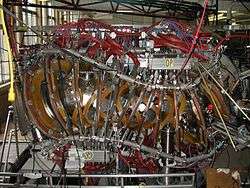Helically Symmetric Experiment
 | |
| Major radius | 1.2 m |
|---|---|
| Minor Radius | 15 cm |
| Heating | 100 kW (ECH) |
The Helically Symmetric Experiment, abbreviated HSX, stylized as Helically Symmetric eXperiment, is an experimental plasma confinement device at the University of Wisconsin-Madison, with design principles that are hoped to be incorporated into a fusion reactor. The HSX is a modular coil stellarator which is a toroid-shaped pressure vessel with external electromagnets which generate a magnetic field for the purpose of containing a plasma.
Background
A stellarator is a magnetic confinement fusion device which generates all required magnetic fields to confine high temperature plasma by external magnetic coils. Unlike in tokamaks and reversed field pinches, no toroidal plasma current is required in stellarators to confine the plasma. Lack of this large externally driven plasma currents makes stellarators suitable for steady-state fusion power plant. However, due to non-axisymmetric nature, conventional stellarators have a combination of toroidal and helical modulation of the magnetic field on a magnetic field line that leads to high transport of plasma out of the confinement volume at fusion relevant conditions. This large transport in conventional stellarators can limit their performance as a fusion reactor.
This problem can be largely reduced by tailoring the magnetic field geometry. The dramatic improvements in computer modeling capability in the last two decades has helped to "optimize" the magnetic geometry to reduce this transport resulting to a new class of stellarators called "quasi-symmetric stellarators". Computer-modeled odd-looking electromagnets will directly produce the needed magnetic field configuration. These devices combine good confinement properties of tokamaks and steady-state nature of conventional stellarators. The Helically Symmetric Experiment (HSX) at the University of Wisconsin-Madison is a quasi-helically symmetric stellarator (helical axis of symmetry).
Project history and timeline
Design started around 1990.[1] By 2007 there were publications on the plasma behaviour.[1]
Device
The magnetic field in HSX is generated by a set of 48 twisted coils arranged in four field periods. HSX typically operates at a magnetic field of 1 Tesla at the center of the plasma column. A set of auxiliary coils is used to deliberately break the symmetry to mimic conventional stellarator properties for comparison.
HSX vacuum vessel is made of stainless steel, and is helically shaped to follow the magnetic geometry.
Plasma formation and heating is achieved using 28 GHz, 100 kW electron cyclotron resonance heating (ECRH). A second 100 kW gyrotron has recently been installed on HSX to perform heat pulse modulation studies.
Operations
Plasmas as high as 3 kilo electronvolts in temperature and about 8x1012/cc in density are routinely formed for various experiments.
Subsystems, diagnostics
HSX has a large set of diagnostics to measure properties of plasma and magnetic fields. The following gives a list of major diagnostics and subsystems.
- Thomson scattering
- Diagnostic neutral beam
- Electron cyclotron resonance heating system
- Electron cyclotron emission radiometers
- Charge exchange recombination spectroscopy
- Interferometer
- Motional Stark effect
- Heavy ion beam probe (coming soon)
- Laser blow-off
- Hard and soft-X-ray detectors
- Mirnov coils
- Rogowski coils
- Passive spectroscopy
Goals and major achievements
HSX has made and continues to make fundamental contributions to the physics of quasisymmetric stellarators that show significant improvement over the conventional stellarator concept. These include:
- Measuring large ion flows in the direction of quasisymmetry
- Reduced flow damping in the direction of quasisymmetry
- Reduced passing particle deviation from a flux surface
- Reduced direct loss orbits
- Reduced neoclassical transport
- Reduced equilibrium parallel currents because of the high effective transform
Ongoing experiments
A large number of experimental and computational research works are being done in HSX by students, staff and faculties. Some of them are in collaboration with other universities and national laboratories, both in the USA and abroad. Major research projects at present are listed below:
- Effect of quasi-symmetry on plasma flows
- Impurity transport
- Radio frequency heating
- Supersonic plasma fueling and the neutral population
- Heat pulse propagation experiments to study thermal transport
- Interaction of turbulence and flows in HSX and the effects of quasi-symmetry on the determination of the radial electric field
- Equilibrium reconstruction of the plasma density, pressure and current profiles
- Effects of viscosity and symmetry on the determination of the flows and the radial electric field
- Divertor flows, particle edge fluxes
- Effect of radial electric field on the bootstrap current
- Effect of quasi-symmetry on fast ion confinement
See also
- Fusion reactor
- Other modern stellarators:
- Wendelstein 7-X, Germany, quasi-axisymmetric, 2015-
- Large Helical Device, Japan, 1998-
- National Compact Stellarator Experiment, quasi-axisymmetric, construction halted 2008
References
- 1 2 ScienceDaily (2007-03-12). "A Step Toward Fusion Energy". ScienceDaily.com.
Additional resources
- Canik, J. M.; D. T. Anderson; F. S. B. Anderson; K. M. Likin; J. N. Talmadge & K. Zhai (23 February 2007). "Experimental Demonstration of Improved Neoclassical Transport with Quasihelical Symmetry". Phys. Rev. Lett. 98 (8): 085002. Bibcode:2007PhRvL..98h5002C. doi:10.1103/PhysRevLett.98.085002. PMID 17359105. Retrieved 2007-03-29.
External links
- Official website
- Experimental Tests of Quasisymmetry in HSX. Talmadge Slide 4 compares with tokamak